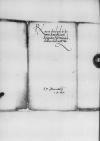List #2264
Samuel MACIEJOWSKI do Ioannes DANTISCUSCracow (Kraków), 1540-01-05
| odebrano 1540-01-17 Rękopiśmienne podstawy źródłowe:
| ||||
Tekst + aparat krytyczny + komentarz Zwykły tekst Tekst + komentarz Tekst + aparat krytyczny
Reverendissimo in Christo Patri et Domino, domino
Reverendissime in Christo Pater et Domine, domine observatissime.
Officiosissimam obsequiorum commendationem.
In causa serenissimi
Quod rem attinet monetariam, dictus est iam dies
De
Quod superest, annum hunc novum faustum et felicem precor Reverendissimae  BCz, 1597, p. 906 Dominationi Vestrae. Cuius me favori commendo.
BCz, 1597, p. 906 Dominationi Vestrae. Cuius me favori commendo.
Dat(ae) or Dat(um)⌈Dat(ae)Dat(ae) or Dat(um)⌉
Eiusdem Dominationis Vestrae Reverendissimae servitor
Eiusmodi litterae[1] scriptae sunt ad
Magnifice sincere nobis dilecte.
Cum propter pestis metum nondum in terris nostris
Dat(ae) or Dat(um)⌈Dat(ae)Dat(ae) or Dat(um)⌉
Ad etc.



